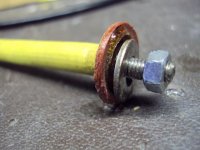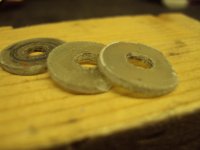does it matter? I have these output transformers that I'm going to use for my Baby Huey PP EL84. They have ferrous (magnetic) bolts and no bushing.
I'd prefer them to be like my Magnequest Iron...i.e. nylon bushing and brass. I.e. non magnetic. So I'll be replacing them.
Do you care? Does it matter? And if it matters it probably matters very little?
I'd prefer them to be like my Magnequest Iron...i.e. nylon bushing and brass. I.e. non magnetic. So I'll be replacing them.
Do you care? Does it matter? And if it matters it probably matters very little?
it matters - if they contact any of the laminations and form a magnetic path. For the very limited cost and hassle, I'd replace them
I'm not the expert on this, but of all the many output transformers I've seen, I've never seen one that didn't have an insulating shoulder washer on at least one end. Either that or non magnetic bolts. There must be some reason for this because I keep thinking of a shaded pole motor. You know the kind that has a copper shunt around part of the pole piece. It's effecting the core's flux somehow. Special washers cost money and I don't think it's there to protect the paint.
Thanks for the replies guys. I would have changed them anyway because I would always be thinking...what if.
Well even if they don't touch the laminations, isn't it. Purely because they are magnetic.if they contact any of the laminations and form a magnetic path
Magnetic or not, they are metal in the magnetic path and will have a current induced in them.
If you want to try a real difference, try a nylon bolt 🙂
Cheers!
If you want to try a real difference, try a nylon bolt 🙂
Cheers!
The nylon bushing is to insulate one end of the lamination stack from the other. If you don't put it in, you will create a path for currents to flow and heat up the transformer.
Please try before and after.. . .
Do you care? Does it matter? And if it matters it probably matters very little?
If you can honestly hear or measure something, I offer you a pair of mine design 😉
(I speak about transformers, of course)
Thank in advance.
Yves.
Ok Yves..will try before and after. Damn now I have to go looking for the bolts and nuts I threw away last night. 😉
Ok Yves..will try before and after. Damn now I have to go looking for the bolts and nuts I threw away last night. 😉
🙂😀🙂
Don't cheat, use original ones

Nylon Bolts are easily found at the Big Box home centers (ie;Home Depot,Menards,Lowes,etc.) I am not sure of the amount of torque they can take. I might suggest using real Brass.
Brass bolts etc are available at the same places, make sure they are solid brass not plated steel, (I carry a small magnet in my pocket)
Brass bolts etc are available at the same places, make sure they are solid brass not plated steel, (I carry a small magnet in my pocket)
My worry for nylon would be creep, exacerbated by the repetitive stress of magnetostriction. Cure worse than disease.
Sheesh, nylon bolts suck. Might as well just leave it open, let the varnish hold it together.
Isn't the whole point of the core to conduct magnetic flux? Duh, magnetic bolts are good...
Besides, bolts usually go through the center of the "E", where flux is weakest, right where it's diverging to the two legs. You can't even measure the difference (with an HP analyzer, not ears) between brass, steel, titanium or nylon bolts.
Tim
Isn't the whole point of the core to conduct magnetic flux? Duh, magnetic bolts are good...
Besides, bolts usually go through the center of the "E", where flux is weakest, right where it's diverging to the two legs. You can't even measure the difference (with an HP analyzer, not ears) between brass, steel, titanium or nylon bolts.
Tim
My worry for nylon would be using "non-natural" materials. 😉My worry for nylon would be creep, exacerbated by the repetitive stress of magnetostriction. Cure worse than disease.
I've got some brass bolts. Think I'll use them.
Woody...I could use stainless steel...but since I've already got brass ones. I'll be using brass.
Well yes but...Isn't the whole point of the core to conduct magnetic flux? Duh, magnetic bolts are good..
the thinner the laminates the lesser the eddy currents ...i.e. the smaller the losses.
And my theory is that a bolt that is magnetically/electrically connected to each of laminates in effect creates one big solid core.
And a solid core has very big losses which was the reason for using laminates in the first place.
Brass or stainless studding is traditionally used. I would avoid nylon, amide or sim. On E&I power transformers the losses due to eddy fields isn't nil and one stud end is usually insulated. Bolting the shroud flange feet to the chassis completes the single turn eddy curent short circuit.
I recently had to do this treatment on my 600VA transformer, as it was mysteriously getting hot and taking high standing current doing nothing.
One can also make washers out of odd pieces of glassfiber pcb with the copper filed off. the fiberglass dust is an irritant for both skin and lungs. Work it wet.
the fiberglass dust is an irritant for both skin and lungs. Work it wet.
richy
I recently had to do this treatment on my 600VA transformer, as it was mysteriously getting hot and taking high standing current doing nothing.
One can also make washers out of odd pieces of glassfiber pcb with the copper filed off.
 the fiberglass dust is an irritant for both skin and lungs. Work it wet.
the fiberglass dust is an irritant for both skin and lungs. Work it wet.richy
Attachments
. . .
And my theory is that a bolt that is magnetically/electrically connected to each of laminates in effect creates one big solid core.
And a solid core has very big losses which was the reason for using laminates in the first place.
You're right of course.
But lams are "oxyded" after being punched to build up an insulation layer and this is also true for the "holes".
So, unless if you insist using a too large screw, the effetc is usually negligible.
Even if you use brass, you may wrap'em with adhesive ribbon.
About magnetic short, I do beleive that lines of flux travel using the shortest possible path and the screws at the corners are not in the main path.
In some -very- large power units, it happens that lams assembly relies on screws wich are in the path of the flux.
I was told that they may even melt !
I've a question !
When first powering a new power transformer (well, below 400VA) it happens to have an somewhat hi "unloaded" current, 1.5 times what I expected.
I measure that before installing the screws.
After few ON/OFF cycles the current returns to a "normal" value.
Why ? ?
Yves.
When first powering a new power transformer (well, below 400VA) it happens to have an somewhat hi "unloaded" current, 1.5 times what I expected.
I measure that before installing the screws.
After few ON/OFF cycles the current returns to a "normal" value.
Why ? ?
remanence?
remanence?
May be . . .
Usually, current falls when the power was applied so that it produces a "BOING" noise in the iron !
- Status
- Not open for further replies.
- Home
- Amplifiers
- Tubes / Valves
- Non-magnetic bolts that hold an output transformer together

